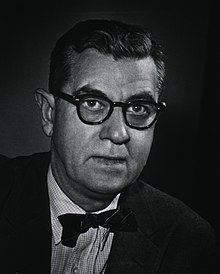James A. Shannon
James Augustine Shannon (born August 9, 1904 in Queens , New York City , † May 20, 1994 in Baltimore ) was an American physician ( nephrologist ) and science manager and director of the National Institutes of Health from 1955 to 1968 .
Shannon studied at the College of the Holy Cross in Worcester, Massachusetts and medicine at New York University with an MD in 1929 and a Ph.D. in physiology in 1935. He was a member of the faculty from 1931, where he dealt with kidney research. From 1941 he was Assistant Professor and 1942 Associate Professor at New York University, which he remained until 1946. He was responsible for the university's new Goldwater Memorial Hospital on what is now Roosevelt Island, which was used for research and, in particular, for malaria research during World War II, for which the clinical tests of chemotherapy drugs took place there. From 1946 to 1949 he was director of the Squibb Institute of Medical Research. During this time he convinced the institute's sponsor, the pharmaceutical company ER Squibb , to start producing the antibiotic streptomycin . He was from 1949 at the National Institutes of Health, where he directed and built research at the National Heart Institute. In 1952 he was responsible for all research (In House Research) and in 1955 Director. During his thirteen-year tenure, he was able to increase the budget by an average of 20 percent per year to $ 1.4 billion at the end of his tenure and made the NIH one of the world's largest funding institutions for biomedical research. After retiring in 1968, he was advisor to the President of the National Academy of Sciences and in 1970 he became Professor of Biomedicine at Rockefeller University and assistant and advisor to its President. From 1975 to 1980 he was adjunct professor there.
He researched the physiology of the kidneys and clinical nephrology (diseases of the kidney) and his research during World War II on drugs against malaria (development of chloroquine , urgently needed by the US armed forces during the South Pacific War because the Japanese conquest of Southeast Asia quinine Interrupted supplies) brought him the Presidential Medal of Merit in 1948.
In 1974 he received the National Medal of Science . He was a member of the National Academy of Sciences , the American Academy of Arts and Sciences, and the American Philosophical Society and was a temporary presidential advisor. He was a Fellow of the Royal College of Physicians .
He had been married to doctor Alice Waterhouse since 1933 and had a son and a daughter. The central administration building of the NIH is named after him.
literature
- Thomas J. Kennedy: James Augustine Shannon 1904–1994, Biographical Memoirs National Academy 1998
Web links
- Wolfgang Saxon, obituary in the New York Times, May 24, 1994
- Biography at the Royal College of Physicians
Individual evidence
- ↑ Book of Members 1780 – present, Chapter S. (PDF; 1.4 MB) In: American Academy of Arts and Sciences (amacad.org). Accessed September 24, 2017 .
- ^ Member History: James A. Shannon. American Philosophical Society, accessed December 2, 2018 .
| personal data | |
|---|---|
| SURNAME | Shannon, James A. |
| ALTERNATIVE NAMES | Shannon, James Augustine |
| BRIEF DESCRIPTION | American medic |
| DATE OF BIRTH | August 9, 1904 |
| PLACE OF BIRTH | New York City |
| DATE OF DEATH | May 20, 1994 |
| Place of death | Baltimore |
